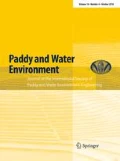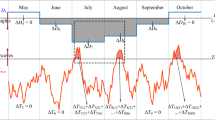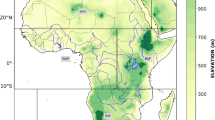Abstract
Drought is a natural phenomenon which starts with decreased precipitation and can disrupt the environmental systems by changing the hydrological cycle. This is more conspicuous in hydrological drought. In analysis of hydrological drought, two factors of severity (intensity) and duration play eminent role. These characteristics are highly related and therefore their combined analysis contributes to better understanding of the drought situation. In this research, by using 40-year (1974–2014) daily discharge data of Tajan River, located in Mazandaran province, Iran, and low-flow indices, the best evaluation index of hydrological drought was determined and 10 past hydrological drought events in the region were identified. Then, the best statistical distribution of both drought variables (duration and severity) was selected, based on the goodness-of-fit tests. Five copula functions were fitted to the data. Results showed that Galambos function with the highest maximum log-likelihood (− 8.934) was selected as the best copula function. Results of the bivariate (duration and severity) statistical distribution could be used to analyze the probability of hydrological drought in the region. This bivariate and conditional probability for the worst drought, with duration of 5 months and severity of 0.32, was 6.1 and 28.5%, respectively.









Similar content being viewed by others
References
Cancelliere A, Salas JD (2004) Drought length properties for periodic-stochastic hydrologic data. Water Resour Res. https://doi.org/10.1029/2002WR001750
Chen L, Singh VP, Guo S, Mishra AK, Guo J (2013) Drought analysis using copulas. J Hydrol Eng 18(7):797–808. https://doi.org/10.1061/(ASCE)HE.1943-5584.0000697
Cisty M, Celar L, Becova A (2015) Application of copulas in analysis of drought and irrigation. In: The ninth international conference on advanced engineering computing and applications in sciences, Bratislava, Slovakia
De Michele C, Salvadori G (2003) A generalized Pareto intensity-duration model of storm rainfall exploiting 2-copulas. J Geophys Res 108(D2):4067
Fleig AK, Tallaksen LM, Hisdal H, Demuth S (2006) A global evaluation of streamflow drought characteristics. Hydrol Earth Syst Sci 10:535–552
Hadiani MO, Jahanbakhsh Asl S, Rezaei Banafsheh M, Dinpashoh Y, Jahanbani M (2013) Investigating the trend of low flow changes of glacial snow regime rivers in Mazandaran province. Int J Agric Crop Sci 6(14):982–987
Kousari MR, Dastorani MT, Niazi Y, Soheili E, Hayatzadeh M, Chezgi J (2014) Trend detection of drought in arid and semi-arid regions of Iran based on implementation of reconnaissance drought index (RDI) and application of non-parametrical statistical method. Water Resour Manag 28:1857–1872. https://doi.org/10.1007/s11269-014-0558-6
Kwak J, Kim S, Kim G, Singh VP, Park J, Kim HS (2016) Bivariate drought analysis using streamflow reconstruction with tree ring indices in the Sacramento Basin, California, USA. Water 8(4):122. https://doi.org/10.3390/w8040122
Nalbantis I, Tsakiris G (2009) Assessment of hydrological drought revisited. Water Resour Manag 23:881–897
Nazemi A, Elshorbagy A (2011) Application of copula modelling to the performance assessment of reconstructed watersheds. Stoch Environ Res Risk Assess 26(2):189–205
Nelsen RB (2006) An introduction to copulas. Springer, New York
Niu J, Chen J, Sun L (2015) Exploration of drought evolution using numerical simulations over the Xijiang (West River) basin in South China. J Hydrol 526:68–77
Peters E, Bier G, van Lanen HAJ, Torfs PJJF (2006) Propagation and spatial distribution of drought in a groundwater catchment. J Hydrol 321:257–275
Piechota TC, Dracup JA (1996) Drought and regional hydrologic variation in the United States: associations with the El Niño-Southern oscillation. Water Resour Res. https://doi.org/10.1029/96WR00353
Reddy MJ, Ganguli P (2012) Bivariate flood frequency analysis of upper Godavari river flows using Archimedean copulas. Water Resour Manag 26(14):3995–4018
Serinaldi F, Bonaccorso B, Cancelliere A, Grimaldi S (2009) Probabilistic characterization of drought properties through copulas. Phys Chem Earth 34(10–12):596–605
Shiau J (2006) Fitting drought duration and severity with two-dimensional copulas. Water Resour Manag 20(5):795–815
Shiau JT, Feng S, Nadarajah S (2007) Assessment of hydrological droughts for the Yellow River, China, using copulas. Hydrol Process 21:2157–2163
Sklar A (1959) Distribution functions of n dimensions and margins, vol 8. Institute of Statistics of the University of Paris, Paris, pp 229–231 (in French)
Song S, Singh VP (2010) Meta-elliptical copulas for drought frequency analysis of periodic hydrologic data. Stoch Environ Res Risk Assess 24:425–444
Tallaksen LM, van Lanen HAJ (2004) Hydrological drought processes and estimation methods for streamflow and groundwater. Developments in Water Science, 48. Elsevier, Amsterdam
Tallaksen LM, Hisdal H, van Lanen HAJ (2006) Propagation of drought in a groundwater fed catchment, the Pang in UK. In: Proceedings of the fifth FRIEND world conference (climate variability and change-hydrological impacts), Havana, Cuba, November 2006, IAHS Publ. 308, pp 128–133
Van Huijgevoort MHJ, Van Lanen AHJ, Teuling AJ, Uijlenhoet R (2014) Identification of changes in hydrological drought characteristics from a multi-GCM driven ensemble constrained by observed discharge. J Hydrol 512:421–434
Vasiliades L, Loukas A, Liberis N (2011) A water balance derived drought index for Pinios River Basin, Greece. Water Resour Manag 25:1087–1101
Wilhite DA, Glantz MH (1985) Understanding the drought phenomenon: the role of definitions. Water Int 10(3):111–120
Wilhite DA, Svoboda MD, Hayes MJ (2006) Understanding the complex impacts of drought: a key to enhancing drought mitigation and preparedness. Water Resour Manag 21:763–774
Wong G, van Lanen HAJ, Torfs PJJF (2013) Probabilistic analysis of hydrological drought characteristics using meteorological drought. Hydrol Sci J 58(2):253–270
Yevjevich V (1967) An objective approach to definitions and investigations of continental hydrologic droughts. Hydrology Papers, No. 23, Colorado State University, Fort Collins
Zhang L, Singh VP (2012) Bivariate rainfall and runoff analysis using entropy and copula theories. Entropy 14:1784–1812
Author information
Authors and Affiliations
Corresponding author
Rights and permissions
About this article
Cite this article
Vaziri, H., Karami, H., Mousavi, SF. et al. Analysis of hydrological drought characteristics using copula function approach. Paddy Water Environ 16, 153–161 (2018). https://doi.org/10.1007/s10333-017-0626-7
Received:
Revised:
Accepted:
Published:
Issue Date:
DOI: https://doi.org/10.1007/s10333-017-0626-7




